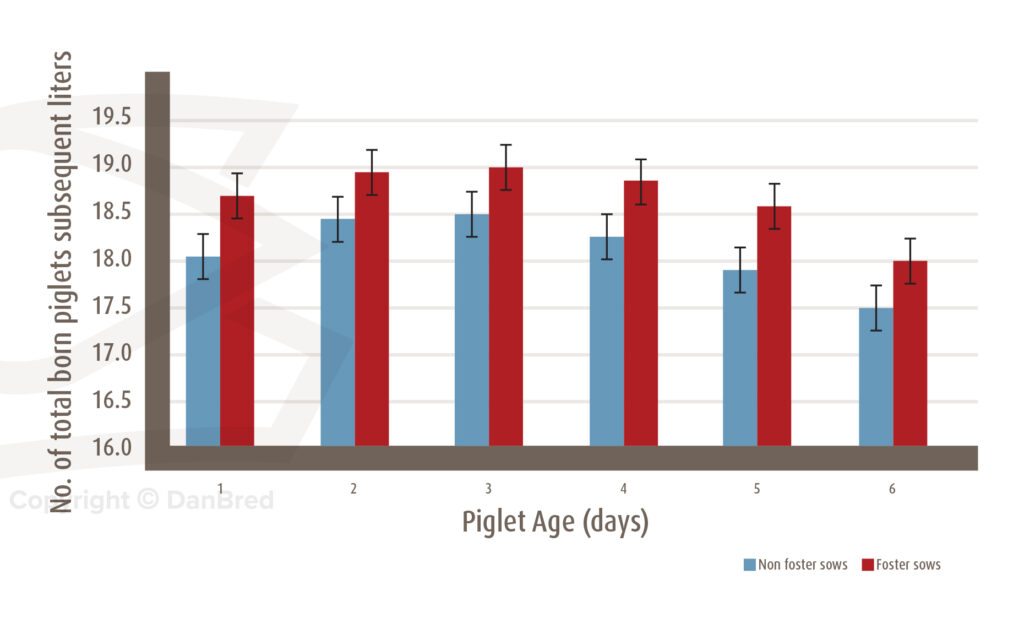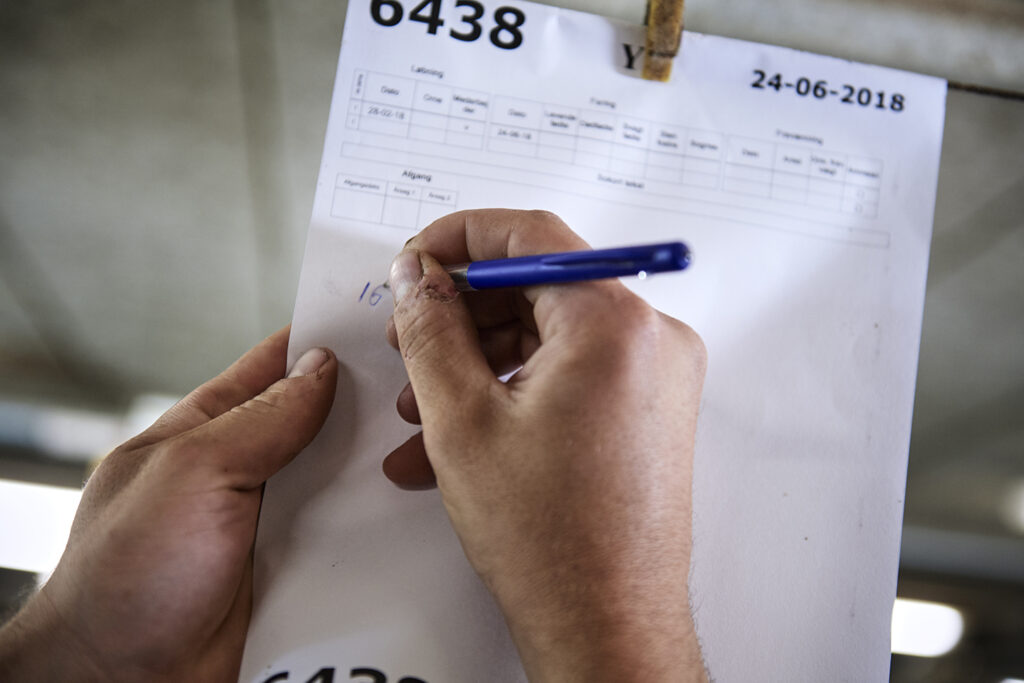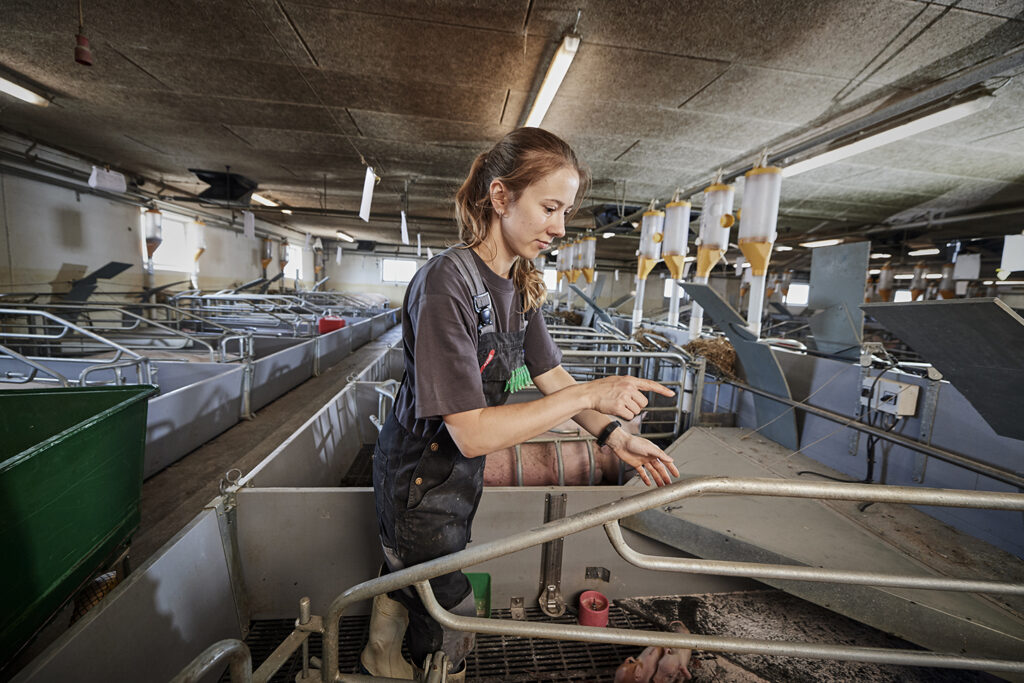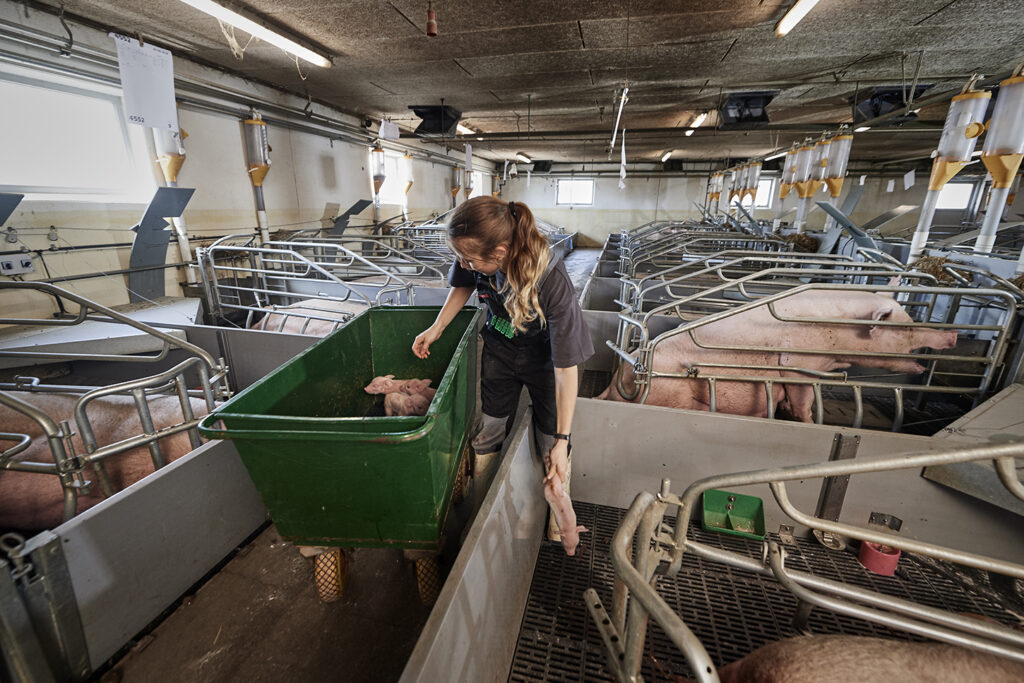Large litters – Correct handling
Content
How to set-up and manage foster sows for large litters
Success in managing hyper prolific DanBred sows is centered around piglet management. Knowing how to rear the extra piglets is essential to capture the full production potential of the DanBred female.
Correct handling of large litters for maximum performance
 Success in managing hyper prolific DanBred genetics is reliant on the correct management of piglets and large litters. As a result of the successful development in litter size, knowing how to rear the additional pigs is necessary to capture the full production potential of the DanBred female.
Success in managing hyper prolific DanBred genetics is reliant on the correct management of piglets and large litters. As a result of the successful development in litter size, knowing how to rear the additional pigs is necessary to capture the full production potential of the DanBred female.
Successful management of litter equalisation, where excess piglets from large litters are distributed among sows with smaller litters, is a critical management step. Nurse sows, where excess piglets from large litters are placed with a foster mother is essential to improve the number of full value weaned pigs.
Success when cross-fostering piglets
The correct management of litter equalisation and setup of nurse sows to raise additional piglets from hyper prolific sows will increase the number of weaned pigs per sow per year, increase growth rates and reduce weight variations among piglets.



Results have shown that the use of nurse sows will give a significant increase in average daily gain as well as weight at weaning (Thorup & Nielsen, 2017).
The fact that a sow has been fostering excess piglets from large litters does not affect the subsequent litter performance, on the contrary, results from nearly 80,000 farrowings where sows raising their piglets were compared to nurse sows raising excess piglets from large litters, showed an increase of 0.57 total born piglets in subsequent litters of the nurse sows (Bruun et. al., 2015).
Furthermore, it has shown that nurse sows do not suffer from stress any more than other sows during lactation (Amdi et. al., 2017).
It is imperative for success with nurse sows to focus on the correct nurse sow selection- this important management strategy will help to ensure the maximization of quality weaned piglets.
A successful system is the 2-step-foster sow where the piglets from a sow 21 days into lactation are weaned (intermediate sow). This sow receives the full litter from a sow which farrowed 4-7 days ago (foster sow).
Newborn piglets from large litters are then placed with the foster sow. Piglet mortality with the 2-step sow was significantly lower and weight at weaning was significantly higher when comparing nurse sow systems in a Danish setup (Thorup & Sørensen, 2017).
When working with nurse sow systems it is important to focus on health and never move piglets if it can compromise the health- if in doubt consult the herd veterinarian.
Always choose sows in good body condition that is eating well, with healthy large piglets, as she must be able to tolerate the extended lactation period.
Easy steps for setting up successful cross-fostering
 Successful management of litter equalisation and the correct nurse sow identification is essential to increase the number of weaned pigs from large litters in professional pig production systems. At entry into the farrowing unit, note the number of available and functional teats and make an overall evaluation of how many piglets each sow is expected to raise.
Successful management of litter equalisation and the correct nurse sow identification is essential to increase the number of weaned pigs from large litters in professional pig production systems. At entry into the farrowing unit, note the number of available and functional teats and make an overall evaluation of how many piglets each sow is expected to raise.

Colostrum
New-born piglets are not protected by an active immune system, which is why their health relies on the passive immunisation gained from colostrum. Before moving any piglet sufficient colostrum intake should be ensured.
- Ensure all new born piglets get to the udder
- Ensure all piglets get at least 12 hours for colostrum intake with their mother
 Split suckling
Split suckling
- Split the litter into two groups – smaller piglets and bigger piglets.
- Keep the group of bigger, viable piglets enclosed
- Allow the smaller piglets to suckle for 60-90 minutes
- Swap the groups over and let the bigger piglets get 30-45 minutes of suckling
Litter equalisation
- Equalise the litters to the number of piglets the sow has been assessed to nurse
- Young sows must nurse at least the same number of piglets as the number of good active teats available (if capable, an additional piglet should be given)
- Move the bigger excess piglets and leave the smaller piglets with their mother
- Equalise the litters until 48 hours after farrowing, after which time piglets should not be moved unless absolutely necessary

Choosing the right nurse sow
- 1stor 2nd parity sow.
- Ideal body condition and optimum back fat thickness is 14-17 mm.
- Calm temperament
- Small active well placed teats and good onset of lactation
- Good strong piglets from her own litter
- Good appetite and feed intake
The 2-step-nurse sow
- Give the nurse sow the same number of piglets as were moved
- Separate the piglets from their new sow
- Give the sow a feed ration
- Release the piglets when the sow lays down
- Make sure all piglets get to the udder
- Reduce feed allowance of the nurse sow to 2 kg per day (this can be increased as the piglets grow)
Nurse sow for smaller piglets
Using a sow for the smaller piglets can increase the average weight gain.
Setup in 3 steps:
- A newly farrowed nurse sow receives smaller excess nurse-piglets from large litters.
- The largest piglets from the newly farrowed nurse sows are moved to a sow 4-7 days into lactation.
- The 4-7 days old piglets are moved to a sow which has just weaned piglets after 21 days of lactation.
Important factors to remember:
- The newly farrowed nurse sow should be a 1st, 2nd or 3rd parity sow.
- The nurse-piglets must have had colostrum for at least 12 hours before they are moved.
- The nurse sow must have small accessible teats and have show good milking abilities.
References
Amdi, C.; Moustsen, V.A.; Oxholm, L.C.; Baxter, E.M.; Sørensen, G.; Eriksson K.B.; Diness L.H.; Nielsen M.F; Hansen, C.F. (2017): Comparable cortisol, heart rate and milk let-down in nurse sows and non-nurse sows. Livestock Science. 198, 174-181
Bruun, T.S.; Vinter, J.; Schop, M.; Amdi, C.W.; Strathe, A.B; Hansen, C.F. (2015): Dataanalyse: Ammesøers efterfølgende reproduktion. Meddelelse nr. 1029. Videncenter for Svineproduktion, Den rullende afprøvning.
Thorup, F.; Nielsen M.F (2017): Tilvæksten falder når de små pattegrise bliver hos egen moder ved kuldudjævning. Meddelelse nr. 1099. SEGES – Videncenter for Svineproduktion.
Thorup, F.; Sørensen A.K. (2005): Et- og to-trins ammesøer. Meddelelse nr. 700. Videncenter for Svineproduktion, Den rullende afprøvning.




